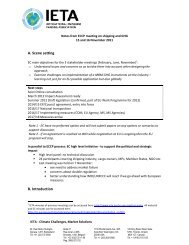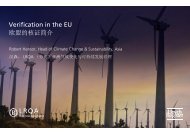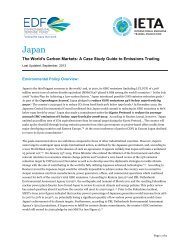Switzerland - International Emissions Trading Association
Switzerland - International Emissions Trading Association
Switzerland - International Emissions Trading Association
Create successful ePaper yourself
Turn your PDF publications into a flip-book with our unique Google optimized e-Paper software.
Emission Credit Abbreviation Kyoto Code OffsetableAgainst KyotoTarget LimitTradableBankableCH EU IntlAssigned Amount AAU 1 ✓/ ✗ ✓ ✓ ✓ ✓UnitRemoval Unit RMU 2 ✓ ✓ ✓ ✓ ✗Emission Reduction ERU 3 ✓ ✓ ✓ ✓ ✓Unit (converted fromAAU)Emission Reduction ERU 4 ✓ ✓ ✓ ✓ ✓Unit (converted fromRMU)Certified Emission CER 5 ✓ ✓ ✓ ✓ ✓ReductionTemporary CER tCER 6 ✓ ✓ ✓ ✓ ✗Long-term CER lCER 7 ✓ ✓ ✓ ✓ ✗European UnionAllowanceEUA 0 ✗ ✗ ✓ ✗ ✓Table 1: Emission Credits: Types, Offsettability, and Tradability. Source: FOEN (2007) 29<strong>Switzerland</strong> and EU have initiated discussions about linkage. According to Aldy and Stavins (2012), this link islikely to become effective in 2014. 30 The Swiss are in favor of linking with the EU ETS because a larger marketprovides for greater cost-effective reduction potential, liquidity, price stability, and flexibility in achieving targets.Furthermore, linkage would enable Swiss companies to participate in the same market as EU business partners. 31According to FOEN (2011), “the Swiss Federal Council has also proposed that the Swiss ETS be adapted in the contextof the ongoing complete revision of the CO2 Act with a view to attaining a high level of compatibility with the EUETS.” 32MARKET REGULATION AND OVERSIGHT: Swiss ETS credits exist electronically and are listed on the FOENmanaged33 National <strong>Emissions</strong> <strong>Trading</strong> Registry, which is an online accounting system that, according toFOEN (2011), “ensures the issuance, holding, transfer, acquisition, cancellation and surrender of emission credits areaccurately recorded.” 34 After the federal government approves a company’s baseline, the agreed-upon quantity ofallowances (the amount of tax-exempt emissions) appears on the Registry under the company’s name. Companieswith emissions that exceed their allowance allocation buy credits on the Registry, and companies that emit belowtheir caps either bank or sell credits. The annual submission of credits occurs via the Registry and Registry data mustbe published electronically, unless specially protected. The Registry also connects Swiss ETS participants to Kyotoflexibility mechanisms, and transactions involving these units are subsequently approved by the UN.For 2008-2012, the penalty for companies that failed to achieve their Swiss ETS targets was retroactive payment ofthe carbon levy (plus interest) for each ton of CO2 emitted since the company’s exemption. 35 For 20013-2020,companies that fail to surrender enough emissions allowances and/or emissions reduction certificates must pay theConfederation CHF $125/tCO2e by the following year. 36COMPLEMENTARY AND SUPPLEMENTARY MEASURES: As noted above, the CO2 Act envisions the SwissETS and the carbon levy as alternative compliance options. This dual-policy approach allows companies to bypasscarbon levy payments if they voluntarily join the Swiss ETS. Beginning in 2013, specified companies face mandatoryETS participation. 37Page 4 of 8









![South Korea [PDF] - International Emissions Trading Association](https://img.yumpu.com/38055599/1/190x245/south-korea-pdf-international-emissions-trading-association.jpg?quality=85)

